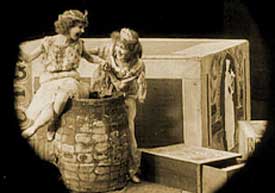 The same year J. Stuart Blackton filmed his wonderful version of A Midsummer Night's Dream (1909), he also filmed the delightful fantasy Princess Nicotine; or, The Smoke Fairy (1909). The same year J. Stuart Blackton filmed his wonderful version of A Midsummer Night's Dream (1909), he also filmed the delightful fantasy Princess Nicotine; or, The Smoke Fairy (1909).
It is one of the most charming trick-films from near the end of the kinetoscope era, with product placement for Sweet Corporal cigars & cigarettes. Together with Midsummer Night, it represents the height of J. Stuart Blackton's imaginative art.
A man (Paul Panzer) sitting beside a table nods off, so doesn't notice the cigar box opens itself & out step a teency tiny fairy mother & her child the Princess Nicotine (Gladys Hulette).
Cut to close-up, the wee mother empties the tobacco out of a pipe bowl, & the girl climbs inside it. The mother then packs the tobacco back into the bowl, before climbing back into the cigar box to hide.
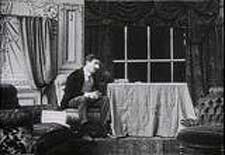 In a moment the gentleman perks up & decides he wants to smoke his pipe. As he lights it, he sees the little girl inside it pushing the tobacco out. In a moment the gentleman perks up & decides he wants to smoke his pipe. As he lights it, he sees the little girl inside it pushing the tobacco out.
He gets a magnifying glass as he empties her out the bowl. He grabs the girl who has changed into a half-rose half-girl. The girl's face in the center of the rose is smoking a fairy-sized cigarette & blowing smoke in the man's face.
He sets the rose & his pipe on the table & tiptoes out of the room. As soon as he's gone, all the wooden matches come out of the matchbox & march inside the cigar-box. The excellent stop-moton animation continues as a pack of cigarettes leave the pack & also climb into the cigar box. The empty packages & the pipe likewise climb into the box.
Lastly the rose-girl crumbles into petals, the petals circles about & role themselves into a nice looking cigar. That's when the gentleman returns & lights the cigar. He sees that Princess Nicotine is inside the wine bottle on the table, so he breaks open the bottle & begins blowing cigar smoke at the girl to harrass her as she had been harrassing him.
Princess Nicotine stacks up some wooden matches & sets the table on fire, dancing around happily as the gentleman uses a seltzer bottle to put the fire out. So ends the battle between the smoker & Princess Nicotine, & if I don't actually understand what the point was, who cares, it was crazy fun.
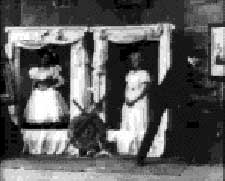 Edwin S. Porter's An Artist's Dream (1900) is a one-minute film very much in the manner of Georges Melies, although to tell the truth it isn't Porter's best Melesian attempt.
Edwin S. Porter's An Artist's Dream (1900) is a one-minute film very much in the manner of Georges Melies, although to tell the truth it isn't Porter's best Melesian attempt.
A horned devil helps two young women out of two boxes which are supposed to be paintings. Although it's doesn't entire succeed in giving the correct impression, it's supposed to depict two portraits sprung to life.
The devil (Mephisto) vanishes, & the artist seated stage left gets up to see what's happening. People are disappearing & reappearing, to what purpose is impossible to say.
Seeing his painted subjects escaped from their frames, he takes up a sword as though to kill women, but the devil reappears & the artist goes down on his knees (though it seems unlikely the filmmaker meant to imply devil worship).
The devil puts the artist to sleep, restores the two women to their picture frames, & reawakens the artist just before vanishing. The artist assuming it was all a dream takes a long pull on a bottle.
A bit less imaginative was Frederick S. Armitage's The Artist's Dream (1899), about a romantic dream of a ballerina. When the artist wakes, there really is a woman in his room, only it's his landlady.
It's scarsely a surprise that Georges Melies himself did a film called The Artist's Dream (Reve d'artiste, 1898), in which an artist falls in love with the idealized woman he has just painted.
When he falls asleep, a young man comes into his art studio, greets the maiden who comes down from the painting, & they dance. She returns to the painting before the artist wakes up, disappointed to find no life in his creation.
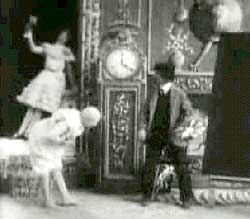 The winner, however, is once again a film by Blackton, The Artist's Dilemma (1901). Another sleepy artist sits at a blank black canvas when a young lady steps out of a grandfather clock & wakes him up. The winner, however, is once again a film by Blackton, The Artist's Dilemma (1901). Another sleepy artist sits at a blank black canvas when a young lady steps out of a grandfather clock & wakes him up.
A great deal is crammed into this two-minute film. Rubbing his eyes of sleep, the artist sets the maiden on a pedestal with a flower in her hand & begins his painting.
Unexpectedly a bald white clown like an aging decrepit version of Peirot steps out of the grandfather clock & begins imploring the posing model. The artist intervenes, but the clown gets a bucket of paint from out of the clock & with a glue brush begins with broad strokes to make a picture appear on the artist's canvas.
When the painting is done, it's a good likeness of the model. She steps down from the canvas & now there are two women, identical twins, who begin to do a jig together, ending with kicks to the head of the clown & the artist.
The twins fold into a single woman whom the artist tries to court, but just as he grabs her to give her a kiss, she turns into the ugly old clown. The clown then jumps toward the clock & disappears, & the artist sets back in his original seat, again sleeping.
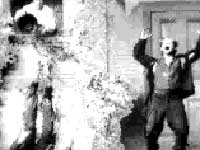 Forgotten today except by hard-core fans of comic strips, Happy Hooligan was familiar to everyone in 1903 from the Hearst newspaper's funny pages. And Happy was one of the key inspirations for Chaplin's Little Tramp.
Forgotten today except by hard-core fans of comic strips, Happy Hooligan was familiar to everyone in 1903 from the Hearst newspaper's funny pages. And Happy was one of the key inspirations for Chaplin's Little Tramp.
Happy was created by Frederick Burr Opper as a tramp often vicitmized by society but never losing his good mood. His brother & opposite in the strip was Gloomy Gus, & it's odd to note that I've from time to time heard someone say "don't be such a gloomy gus" with absolutely no knowledge of the Happy Hooligan strip.
The surviving first film (out of I believe fourteen made) featuring this character was simply titled Happy Hooligan (1900). The copyright date is 1903 for the first installment of Happy's adventures, but they were all actually filmed between 1900 & 1902, copyrighted as an afterthought.
We are quickly introduced to a clown figure with bald-cap having a miniature stovepipe hat on top, & a long putty nose. He's played by the director, J. Stuart Blackton himself.
Happy is enjoying an organ-grinder's performance when a fat woman in an upper window looks out & tries to get the grinder to stop with the racket. Offended or just rude, he plays all the more vigorously.
Happy spots the fuzz coming & warns the grinder to flee. When the cop arrives under the window, the crabby lady has returned with a bucket of water to fling on the grinder, but gets the cop instead. Happy laughs & laughs, as the policeman stamps angrilly inside the house evidently eager to arrest the lady who doused him.
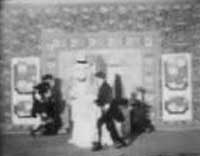 Hooligan Assists a Magician (1900) is not like the comic strip but more in keeping with what had swiftly become the standard "trick film," with Happy co-starring. Hooligan Assists a Magician (1900) is not like the comic strip but more in keeping with what had swiftly become the standard "trick film," with Happy co-starring.
A magician materializes two barrels on a stage & then calls for a volunteer from the audience. The tramp Happy Hooligan rushes on the stage at full tilt.
When he touches the magician, the man vanishes, & Happy puts the magician's empty clothes in one of the barrels. A woman leaps up from the other barrel & wacks him with a rolling pin, then vanishes back in the barrel.
Happy is completely bamboozled by the individuals popping up in the the barrels to hit him. Even when he reduces one barrel to a pile of slats, it reconstitutes itself & someone pops up in it again.
Eventually the magician reappears from a barrel & does several more tricks in quick succession, including manifesting a sheeted spirit. There are many, many funny little touches throughout.
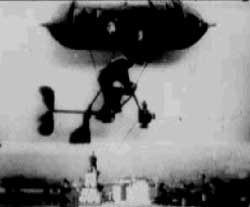 The Twentieth Century Tramp; or Happy Hooligan & His Airship ( 1902), uses "tramp" in a punning manner not only for the rider identified as the cartoon hobo, but also meaning of a "tramp steamer" or similar ship. In this case the ship was a Jules Vernesque flying machine. The Twentieth Century Tramp; or Happy Hooligan & His Airship ( 1902), uses "tramp" in a punning manner not only for the rider identified as the cartoon hobo, but also meaning of a "tramp steamer" or similar ship. In this case the ship was a Jules Vernesque flying machine.
A marvelous mini-derigible is fixed up with a bicycle-operated propeller at the rear. The rider peddles over the city scape, a completely effective & amusing image, despite the too-obvious line between the two parts of the double exposure. The funny little airship continues on over the sea.
There's no context such as a joke or story to this one, although the end of the poorly preserved film may have been truncated, & there's a hazy intimation that the flying bicycle may have blown up at the end.
It's a delightful piece of primitive science fiction. Yet this was the same year that Melies made his elaborate & vastly more sophisticated A Trip to the Moon (La Voyage dans la lune, 1902), & a little surprising Blackton didn't have anywhere for the flying tramp to be visiting.
These are the only three Happy Hooligan films i'Ive seen, & the third seems hardly to have been about Happy Hooligan except as a random designation of the rider.
I don't know how many of the other Happiy Hooligan films survive. They were done by diverse director/photographers, but apparently Blackton played the character even when he didn't make the film. The entire series consisted of:
Happy Hooligan (1900), Happy Hooligan Has Trouble with Cooks (1900), Hooligan Assists a Magician (1900), Happy Hooligan Surpised (1901), Happy Hooligan & the Summer Girls (1901), Hooligan Visits Central Park (1901), Hooligan Takes His Annual Bath (1901), Hooligan Causes a Sensation (1901), Hooligan at the Sea Shore (1901), The Twentieth Century Tramp; or Happy Hooligan & His Airship ( 1902) Happy Hooligan Turns Burglar (1902), Happy Hooligan: Nothing but Fun (1902), Hooligan's Roller Skates (1903), & Happy Hooligan's Interrupted Lunch (1903).
copyright © by Paghat the Ratgirl
|
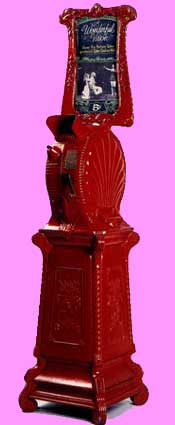

 In a moment the gentleman perks up & decides he wants to smoke his pipe. As he lights it, he sees the little girl inside it pushing the tobacco out.
In a moment the gentleman perks up & decides he wants to smoke his pipe. As he lights it, he sees the little girl inside it pushing the tobacco out.



